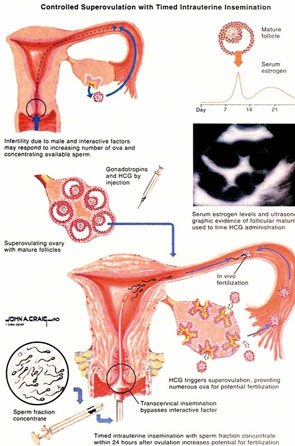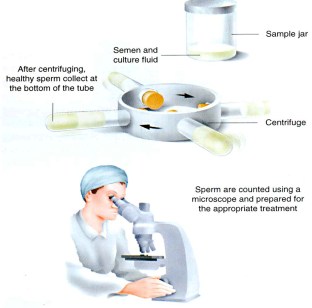Intra Uterine Insemination - IUI
Definition of Intra Uterine Insemination - Artificial Insemination
 This is a procedure to treat infertility. The seminal fluid is prepared in the lab by washing it with a special media, then it is injected inside the uterus, after stimulating the ovaries to produce more eggs at treatment cycle. The sperm swim towards the fallopian tubes to fertilize the waiting egg, resulting in normal pregnancy. This procedure usually takes 15-20 minutes and it is usually done in the clinic of the doctor.
This is a procedure to treat infertility. The seminal fluid is prepared in the lab by washing it with a special media, then it is injected inside the uterus, after stimulating the ovaries to produce more eggs at treatment cycle. The sperm swim towards the fallopian tubes to fertilize the waiting egg, resulting in normal pregnancy. This procedure usually takes 15-20 minutes and it is usually done in the clinic of the doctor.
Indications of Intra Uterine Insemination
Infertility due to abnormal semen:
When semen analysis shows decreased count or motility and increased abnormal sperms, but the count should be acceptable, not perfect, but should be enough to do the procedure, and the motility and the number of normal sperms should be acceptable, and this is decided by the doctor, in these cases the solution can be by doing IUI because the preparation of sperms in this procedure can help in separation of the motile and normal sperms from other sperms.
Cervical factors:
The Cervix is the lower end of the uterus, and it is the opening that is found between the uterus and the vagina. During intercourse, the semen goes inside the vagina and the sperm swims through the cervix in to the uterus, then in to the fallopian tubes to reach the waiting egg.
During ovulation period, fluid is secreted in the cervix, and this fluid prepares the perfect environment for the sperm to reach the fallopian tubes. But, if this secretion was too thick it may hinder the journey of the sperm, or, if there is fibrosis in the cervix from previous operations due to endometriosis, IUI can go beyond the cervix by introducing the sperm into the uterus directly.
Ovulation problems
Semen allergy:
Rarely, some women may be allergic to proteins that are found in the husband's semen, and this causes redness, swelling, and pain in the vagina when the semen touches it during intercourse. Using a condom prevents these symptoms, but it also prevents pregnancy. If the allergy was severe, then IUI may be effective as many semen proteins are removed before IUI.
Unexplained infertility:
IUI is usually used as a first line treatment of unexplained infertility, and sometimes it may be combined with ovarian stimulation.
Antisperm Antibodies
In these cases sperms won't be able to pass through the mucosal secretion in the cervix, so it will not be able to reach the egg. Therefore, this method enables the sperm to go immediately into the uterus.
Erection and Ejaculation Disorders
Mild endometriosis
The cases in which Intra Uterine Insemination is ineffective:
Blocked or damaged fallopian tubes.
- Ovarian failure.
- Severe seminal fluid abnormality.
- Severe endometriosis.
Preparation for Intra Uterine Insemination - Artificial Insemination:
1- Monitoring Ovulation :
Previously, ovulation was monitored by recording body temperature and noting any change in the vaginal discharge, or by doing blood and urine tests in the Days 12-16 of the cycle. Now, the monitoring of ovulation is done by vaginal ultrasound after the woman is given ovarian stimulating drugs to make sure of the maturity of the follicles (the eggs), and the doctor usually prefers having at least 1-3 mature follicles to give the HCG injection. Then, the semen sample is taken, (as it will be explained later), and it will be sent to the lab to be prepared. The preparation of semen usually takes 1-3 hours and IUI is done in the time that is decided by the doctor. In general, the duration of time between giving the injection and doing the IUI is 36-44 hours, and IUI in the next day is done 60 hours after the HCG.
2- Preparation of the semen sample:
A semen sample can be produced by masturbation in the home, or in a special room in the hospital, after 2-5 days of abstinence. The semen is then washed in the lab thereby isolating the normal motile sperms from the abnormal immotile sperm. Then, the sperm is separated from other components of the semen and concentrated in a small amount. Various media and techniques can be used for Preparation of the semen sample. Sperm Preparation takes about 30-60 minutes.
Intra Uterine Insemination Procedure:
IUI is usually done in the clinic of the doctor, and there is no need for medication or an analgesic during the procedure. The speculum is placed in the vagina and cervical area is cleaned, the prepared specimen of highly motile sperm is placed in the uterine cavity using a special flexible catheter.
How many times can the IUI be done?
The IUI is usually done twice during the treatment cycle, and it has been proved that doing the IUI twice increases the pregnancy rate because it decreases the loss of the fertility period during the ovulation, but there was a study that was done comparing the pregnancy rate after IUI on one time, or two times, and found no difference.
After the Intra Uterine Insemination:
- Usually, the IUI procedure takes from 15-20 minutes. The patient is then asked to lie down on her back for a period of time.
- If the semen was not washed properly, the injection of semen into the uterus may cause contractions that pushed the semen out and can cause pain due to special enzymes called prostaglandins that are responsible for the passage of blood during menses.
- The patient can continue her normal life, and passage of a small amount of blood in 1-2 days after IUI is normal.
Intra Uterine Insemination Results
- Pregnancy test should not be done before 2 weeks have past since the IUI. Doing it before this may cause false negative result (which means that the patient is pregnant while the test is negative), and in the cases where hormones are used for ovulation induction, like HCG, doing the pregnancy test before 2 weeks can cause a false positive result (which means that the patient is not pregnant while the test is positive that is caused by the HCG hormone that is found in the blood).
If Intra Uterine Insemination fails, when can it be repeated, and how many times?
- If Intra Uterine Insemination (IUI) fails, it can be repeated 3-6 times to increase the pregnancy rate. It can be repeated after at least one month or more, this depends on the doctor's and the couple's mutual decision. It has been proven that the cumulative pregnancy rate after IUI has been repeated 4 times is 50-60%. If IUI fails after 4 trials, it is preferred not to repeat it. The doctor will decide the next step according to the case.
Success rate of Intra Uterine Insemination - IUI:
-In general, the pregnancy rate of IUI is 10-20% and it depends on the age of the wife, her health situation, and also on the number of motile sperm that is used in each cycle, and the pregnancy rate in 2 IUI cycles using 5 million sperm is more than the pregnancy rate in 1 IUI cycle using 10 million sperm.
- For couples of unexplained infertility, trying for 2 years, female age under 35, and normal sperm, the success rate is as follow:
- 10% chance per month using clomid, and IUI for up to 3 cycles.
- 15-20% chance per month using injection by FSH medication, and IUI for up to 3 cycles.
Our success rate
How many inseminations should one try before resorting to IVF?
- After 3 failed IUIs.
- If the female age is 40 or older or if ovarian reserve is low, consider In Vitro Fertilization earlier.
- Risks of Intra Uterine Insemination - IUI:
Rarely, IUI may cause infection in the uterus and tubes, from bacterial contamination that originate either from semen sample, or contamination of sterile catheter in the vaginal or cervical area during the procedure. Careful cleaning of the cervix and cautious technique alleviate this and make it a rarity.
Dr Najeeb Layyous F.R.C.O.G
Consultant Obstetrician, Gynecologist and Infertility Specialist







 Pregnancy Due Date Calculator
Pregnancy Due Date Calculator
 Chinese Gender Predictor
Chinese Gender Predictor
 Ovulation Calculator
Ovulation Calculator
 IVF Due Date Calculator
IVF Due Date Calculator
